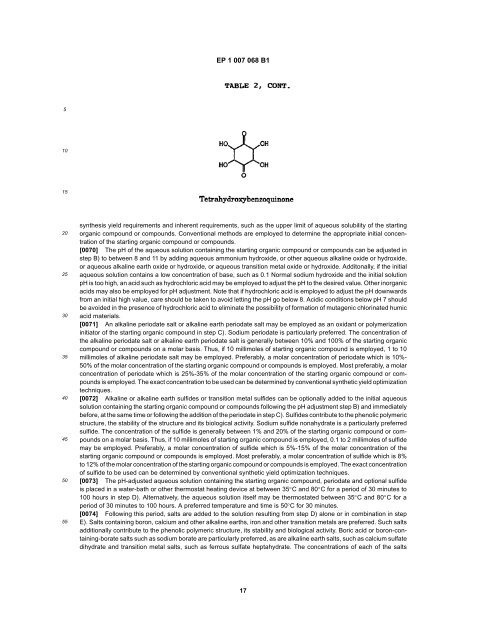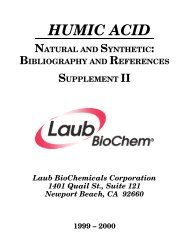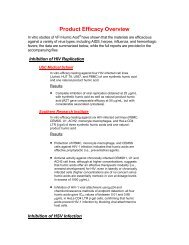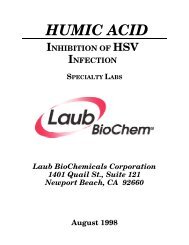EP 1 007 068 B1510152025303540455055synthesis yield requirements and inherent requirements, such as the upper limit of aqueous solubility of the startingorganic compound or compounds. Conventional methods are employed to determine the appropriate initial concentrationof the starting organic compound or compounds.[0070] The pH of the aqueous solution containing the starting organic compound or compounds can be adjusted instep B) to between 8 and 11 by adding aqueous ammonium hydroxide, or other aqueous alkaline oxide or hydroxide,or aqueous alkaline earth oxide or hydroxide, or aqueous transition metal oxide or hydroxide. Additonally, if the initialaqueous solution contains a low concentration of base, such as 0.1 Normal sodium hydroxide and the initial solutionpH is too high, an acid such as hydrochloric acid may be employed to adjust the pH to the desired value. Other inorganicacids may also be employed for pH adjustment. Note that if hydrochloric acid is employed to adjust the pH downwardsfrom an initial high value, care should be taken to avoid letting the pH go below 8. Acidic conditions below pH 7 shouldbe avoided in the presence of hydrochloric acid to eliminate the possibility of formation of mutagenic chlorinated humicacid materials.[0071] An alkaline periodate salt or alkaline earth periodate salt may be employed as an oxidant or polymerizationinitiator of the starting organic compound in step C). Sodium periodate is particularly preferred. The concentration ofthe alkaline periodate salt or alkaline earth periodate salt is generally between 10% and 100% of the starting organiccompound or compounds on a molar basis. Thus, if 10 millimoles of starting organic compound is employed, 1 to 10millimoles of alkaline periodate salt may be employed. Preferably, a molar concentration of periodate which is 10%-50% of the molar concentration of the starting organic compound or compounds is employed. Most preferably, a molarconcentration of periodate which is 25%-35% of the molar concentration of the starting organic compound or compoundsis employed. The exact concentration to be used can be determined by conventional synthetic yield optimizationtechniques.[0072] Alkaline or alkaline earth sulfides or transition metal sulfides can be optionally added to the initial aqueoussolution containing the starting organic compound or compounds following the pH adjustment step B) and immediatelybefore, at the same time or following the addition of the periodate in step C). Sulfides contribute to the phenolic polymericstructure, the stability of the structure and its biological activity. Sodium sulfide nonahydrate is a particularly preferredsulfide. The concentration of the sulfide is generally between 1% and 20% of the starting organic compound or compoundson a molar basis. Thus, if 10 millimoles of starting organic compound is employed, 0.1 to 2 millimoles of sulfidemay be employed. Preferably, a molar concentration of sulfide which is 5%-15% of the molar concentration of thestarting organic compound or compounds is employed. Most preferably, a molar concentration of sulfide which is 8%to 12% of the molar concentration of the starting organic compound or compounds is employed. The exact concentrationof sulfide to be used can be determined by conventional synthetic yield optimization techniques.[0073] The pH-adjusted aqueous solution containing the starting organic compound, periodate and optional sulfideis placed in a water-bath or other thermostat heating device at between 35°C and 80°C for a period of 30 minutes to100 hours in step D). Alternatively, the aqueous solution itself may be thermostated between 35°C and 80°C foraperiod of 30 minutes to 100 hours. A preferred temperature and time is 50°C for 30 minutes.[0074] Following this period, salts are added to the solution resulting from step D) alone or in combination in stepE). Salts containing boron, calcium and other alkaline earths, iron and other transition metals are preferred. Such saltsadditionally contribute to the phenolic polymeric structure, its stability and biological activity. Boric acid or boron-containing-boratesalts such as sodium borate are particularly preferred, as are alkaline earth salts, such as calcium sulfatedihydrate and transition metal salts, such as ferrous sulfate heptahydrate. The concentrations of each of the salts17
EP 1 007 068 B1510152025303540455055employed is generally between 0.1% and 20% of the starting organic compound or compounds on a molar basis.Preferably, a molar concentration of salt which is 0.2% to 10% of the molar concentration of the starting organic compoundor compounds is employed. Most preferably, a molar concentration of salt which is 0.2% to 2% of the molarconcentration of the starting organic compound or compounds, is employed. The exact concentration to be used canbe determined by conventional synthetic yield optimization techniques.[0075] The solution resulting from step E) is allowed to stand at room temperature with or without stirring for a periodof time from 2 to 48 hours in step F). Any precipitate formed at this stage is removed via conventional centrifugation.[0076] Molecules are removed from the solution resulting from step F) below about 500 to about 10,000 daltons instep G). A variety of known conventional techniques can be employed such as preparative chromatography, ultrafiltrationor dialysis. Molecules are preferably removed from the solution resulting from step F) by employing dialysis instep G) with a flow-through open-channel or screen membrane apparatus consisting of a sandwich-type membraneof lower molecular-weight cutoff of 500-10,000 daltons until the conductivity of the solution has dropped to 200 microsiemensor less. Most preferably, molecules are removed from the solution resulting from step F) by employing dialysisin step G) until the conductivity of the solution has dropped to 30 microsiemens or less. A Pall Filtron Ultrasette®Tangential Flow Device or Mini- Ultrasette® Tangential Flow Device used with a Pall Filtron Ultralab® Specialized Pumpand Reservoir System are preferred for solution dialysis.[0077] The conductivity of the solution processed in step G) above can conveniently be monitored with a flow-throughconductivity cell and conductivity meter. Alternatively, a simple inexpensive hand-held combination conductivity cellconductivitymeter (e.g., a Nalcometer Model MLN) can be employed.[0078] Before removing the water from the solution in step H) above, the solution resulting from step G) above canbe further dialyzed with a flow-through apparatus consisting of a sandwich-type membrane of molecular weight cutoffof 50,000 daltons. In this case the filtrate solution, not the retentate, is saved for further concentrating and processingaccording to steps H) and I). The resultant product will have a molecular-weight range of 500-50,000 daltons.[0079] If the solution resulting from either steps G) or H) above is to be stored as an aqueous solution for long periodsof time for later application or use, for example as an anti-viral treatment solution, anti-viral therapy, anti-microbialtherapy, a spray-on fertilizer or soil amendment, it can be filtered through standard 0.2 to 0.4 micron filters to removebacteria and viruses, that is, can be made sterile by filtration. Alternatively, the aqueous solution from either steps G)or H) can be autoclaved for 5-60 minutes at 100-150° C to produce a sterile solution.[0080] Afinal optional step I) in the process of the present invention involves removing water from the solutionresulting from step H). When freeze-drying is employed as the method of water removal in step I) above, the resultantproduct is a light fluffy dark-colored powder that is subject to static electricity effects. To minimize these effects, a smallamount of mannose or other sugar can be added to the solution resulting from step H) just prior to freeze-drying. Waterremoval from the product can be carried out by means other than freeze-drying in step I) above, such as by heatevaporation with or without vacuum, by rotary evaporation, by spray-drying, or by any other solvent-removal techniquethat is convenient as well as economical for aqueous solutions. The dried powder obtained from step I) above can beautoclaved for 15-30 minutes at 100-120° C to produce a sterile powder.[0081] The synthetic humic acid materials produced according to the chemical processes and separation and isolationprocedures of the present invention exhibit the physicochemical properties and attributes of typical naturally-occurringcommercially-available humic acids and other soil extracts.[0082] Afacile method of examining the physicochemical characteristics of the product yielded by steps A) throughH) above, or by modifications thereto, is high-performance liquid chromatography (HPLC). The chromatographic fingerprintpattern so obtained from HPLC also offers a convenient means of comparing one product with another, aswell as comparing each of the synthetic products with naturally-occurring humic acids and other soil-extract materials.The HPLC method is thus used to determine the reproducibility of the physiochemical properties and attributes of thesynthetic phenolic polymeric materials, as well as to determine if the aformentioned properties and attributes simulatethe physiochemical properties and attributes of typical commercial-available natural humic acids and other soil extracts.The latter determination of simulation is done in the conventional manner employing HPLC; e.g., by visually and quantitativelycomparing the HPLC chromatographic fingerprint patterns of the materials. The fingerprint patterns of the twomaterials, one synthetic and one natural, need not be 100% identical to conclude that the physiochemical propertiesand attributes of the synthetic phenolic polymeric material simulates the physiochemical properties and attributes ofthe natural humic acid. An approximate correspondence between the aforementioned HPLC fingerprint patterns is allthat is required to conclude that the synthetic material simulates the natural material. In general, even a 75% visualcorrespondence in 2 HPLC fingerprint patterns is all that is necessary to conciude that one material simulates another.Auseful fingerprint pattern for natural as well as synthetic soil extract materials can be obtained as follows. The columnis comprised of a packing, typically reversed-phase polymer PRP-1 (Hamilton Co.), of particle size 5 microns, andbeing 150 millimeters in length by 4.1 millimeters inside diameter. The mobile phase is comprised of three solutions.Solution A is 0.1 Normal aqueous sodium hydroxide. Solution B is 0.05 Normal of so-called Prideaux universal buffer,which is made by combining 4.25 grams of sodium nitrate (NaNO 3 ), 12.37 grams of boric acid (H 3 BO 3 ), 23.06 grams18










